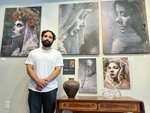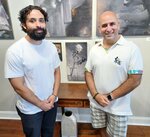

Standing before the large portraits of artist Alfredo Gonzalez, one is pulled into the emotion depicted there — subtle yet powerful, universally and immediately understood: a single tear on a woman’s cheek, an enigmatic expression gazing out from underneath a mantilla, humanity showing through a mask of makeup applied for Dia de los Muertos.
Each work seems to capture a moment from an unspoken narrative, moving a viewer — at least one possessing a talent for introspection — to ponder not just what event precipitated this instant but also what from his or her own experience makes understanding possible.
Each painting is more than it is.
It’s a quality one finds in great works of fine art. What comes as a surprise is the strong working-class roots of these pieces, roots that find expression even in the artist’s choice of tools.
Gonzalez is one of the nine finalists selected by entrepreneur Richard C. Kessler of The Kessler Collection from a pool of 1,800 applicants to display his work in New York City’s Times Square and at several Grand Bohemian Galleries, including one in St. Augustine.
Kessler put out a call in late 2022 for applicants in his search for The Next Original. That competition arrived at what appeared to be a crossroads of sorts for Gonzalez, who was working hard in construction even as he completed coursework for his bachelor’s degree and faced enormous debts.
Gonzalez, who had pursued his art with what some would consider superhuman dedication, needed something to happen. Soon.
And that was when Kessler’s lightning struck.
Street art
Gonzalez grew up in the seaside city of Oxnard, California, west of Los Angeles. His introduction to the world of art — and that of the critic — came when he was in kindergarten.
“We were asked to do a family picture,” he said. “I drew the classic picture of the head with the legs coming out of the head and the arms coming out of the leg. It was just a funny little picture. And I couldn’t figure out why it didn’t look like my parents.”
At some point it occurred to him that anatomy was what made a person unique.
“So, my naïve, 5-year-old self decided to draw breasts on my mom,” he said, laughing. “My teacher pulled me aside. I got into trouble. She called my mom, and my mom talked to me.”
Shortly after this, he went to see James Cameron’s “Titanic.” During the scene where Leonardo DiCaprio’s character sketches a nude of Kate Winslet’s character, Gonzalez’s mother made him turn around. But looking up at the projector’s window, the boy could see a very tiny projected image of the scene, something which prompted him to wonder: “Why isn’t he [DiCaprio’s character] getting into trouble?”
Oxnard had both an art culture and a skateboard culture, and as a boy, Gonzalez found himself drawn to the “funny, funky characters” popular in skateboarding graphics. That led him to graffiti and artists like Shepard Fairey and Banksy. Gonzalez found himself captivated by the color and messages these street artists employed. This also awakened in him a desire to capture emotion in a way that can inspire an entire group of people.
“I consider them some of the first masters that I actually learned about,” Gonzalez said.
Of course, graffiti had a tendency to get artists into trouble, and Gonzalez began a transition to fine arts. An art teacher in high school influenced him to pursue line drawing and figurative life painting.
Out of this, Gonzalez decided he wanted to pursue art but was advised that it was a very difficult field in which to find success.
So his life took a practical turn, one that would have a surprising impact on his future artwork.
A concrete education
Gonzalez’s father was a construction worker who specialized in masonry.
“He has worked for a pool company since I was a little kid; he would make these giant waterfalls out of concrete and stone,” Gonzalez recalled.
One day, his father took him to the job site where he was able to meet the boss. The company then employed Gonzalez during the summers.
He enjoyed mixing and working with concrete but found it tiring. At the end of the day, through his exhaustion, he would try to find the energy to paint.
At last, in 2017, he took a major step forward in his art: he enrolled in the Academy of Art University in San Francisco. He spent a couple of years there, but the COVID-19 pandemic profoundly disrupted his plans.
Amidst the many business closures, Gonzalez was not able to find work, which meant he couldn’t earn money for rent. He moved all of his possessions into his two-door Honda Civic and slept in different rest stops in San Francisco.
“Every day was an adventure,” he said.
In fact, he would find himself completing homework assignments in the car’s passenger seat. He would set his laptop computer on the driver’s side, slide the passenger seat back as far as possible and paint on an 18-by-24-inch canvas.
Finally, he began to drive back and forth between his home in Oxnard and San Francisco, a six-hour trip one way.
“I went straight back into construction, because they were always kind enough to receive me when I needed work,” he said. “So, I would work during the week. Day of class, I’d wake up super early, drive to San Francisco, go to my class, drive back, go straight to work, do homework; same process all over again.”
He hit a place about a year before graduating from the academy where he felt burnt out.
“I was driving back and forth, and I just couldn’t get caught up with bills; I couldn’t get caught up with assignments,” he said.
With all his earnings paying his tuition and other expenses, he survived mostly on vending machines using whatever change he had saved up.
At last, he earned his bachelor’s degree in fine arts but was still not free of all the hard work.
Next Original
Completion of his formal education was not a ticket to a more leisurely lifestyle. Gonzalez continued to work even as he honed his artistic skills.
“I was working in a construction job from about 6 to 4 o’clock,” he said. “After that, I would shoot over to a design shop, and I would do screen printing from about 5 o’clock until about 9 or 10. Then I would go home, try to shower and eat, paint for a couple of hours, sleep and then start the whole process over again.”
His girlfriend encouraged him to keep looking for opportunities for his art. Eventually, he came across the call for artists for The Next Original.
“I was almost like, man, should I even submit? Nothing’s going to happen,” he said. “Just another submission that I’ll do.”
He submitted his work and promptly forgot all about it.
Then, one day in December, he had just returned home from his construction job when the phone rang. The woman at the other end of the line told him he has one of the competition’s finalists and they wanted to fly him and a guest out to Savannah.
“My first response was: This sounds like a scam,” he admitted. “I almost hung up, but she was like, ‘No, no, no. It’s not a scam!’”
He asked the caller to name the pieces he had submitted, and she did.
“I was like: This might be real,” he said. “It ended up being one of the most amazing things that ever happened.”
In Savannah, Kessler listened to the young artist’s story and bought one of his works.
In January, at the suggestion of a Kessler Collection representative and with the blessing of his father, Gonzalez stopped working in concrete and focused on his art.
“I’m super thankful for everything that’s happened since December,” Gonzalez said. “I feel like that’s really allowed me to sit down and really think methodically about what I want to paint, and how I want to paint.”
Developing a series of works, he has chosen to paint in black and white to symbolize concrete, to which he maintains an emotional attachment because it reminds him of his father.
He paints on large canvases, something he came to prefer due to his background in graffiti. He said it allows him to feel a bit more free, but it also has a heightened impact on the viewer.
His painting process is unique. He starts with an acrylic spray paint — which may also harken back to his graffiti days. Then, he applies acrylic paint using a cement trowel, an unusual tool for a fine arts painter but one that makes perfect sense given his familiarity with its use. From there, he finishes his works with traditional paint brushes and oils.
Gonzalez said he wants to inspire others just as he himself was inspired by his instructors and other established artists. He also emphasizes the value of hard work.
“If there’s something you want to do, whether it’s painting, if it’s writing or whatever it is, you’ve just got to be willing to do the work,” he said. “And then just be persistent.”
Anyone interested in seeing Gonzalez’s art can find him on Instagram, @dofreart, or go to his website, dofreart.com. More information is also available at kesslercollection.com.
The Grand Bohemian Gallery is located at 49 King St. in St. Augustine.